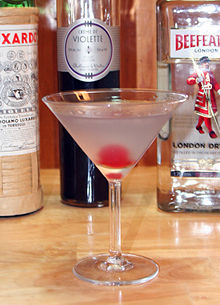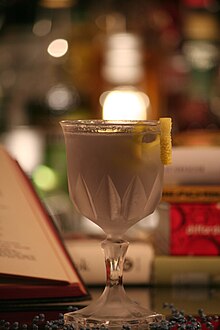Aviation (cocktail)
The Aviation is a classic cocktail made of gin , maraschino liqueur, crème de violette (violet liqueur) and lemon juice. By combining a basic spirit with citrus juice and a source of sugar - here the liqueurs - the short drink can be classified in the group of sours . Its name comes from the cocktail probably its delicate silvery-gray color by the violet liqueur, of the sky and the emerging time of its construction in the early 20th century aviation ( Engl. "Aviation") recalls.
history
The original recipe for the Aviation Cocktail appeared in Hugo Ensslin's recipe collection Recipes for Mixed Drinks in 1916 . The German-born Ensslin worked as a bartender at the Wallick Hotel in New York's Times Square, the former Barrett House (1882 – ca. 1900) and Cadillac Hotel (around 1900–1910), whose bar was closed in 1919 after the merger with the Claridge Hotel. Ensslin had self-published his recipe book, and a second, expanded edition followed in 1917. According to cocktail historian David Wondrich, however, the aviation was already included in the first edition. Ensslin's Aviation Cocktail was quite sour and consisted of 1/3 lemon juice, 2/3 tbsp Bart gin, 2 dashes (spritzers) maraschino liqueur and 2 dashes crème de violette , to be shaken with pieces of ice and - as usual without ice - in a Strain cocktail glass . This original recipe - only without mentioning the gin brand - was later taken up again by Patrick Gavin Duffy in his book Official Mixer's Manual (1934). Previously, the London bartender Harry Craddock, like Duffy without citing the source, had included them in his 1930 Savoy Cocktail Book , albeit with one crucial mistake: he omitted the violet liqueur. Because of the book's popularity - Craddock was President of the United Kingdom Bartenders' Guild. and the book was published again and again - in the following decades only this variant of two parts gin, one part lemon juice and two dashes maraschino spread. By the beginning of the 21st century, the cocktail had almost been forgotten and was listed in recipe collections only without violet liqueur, if at all. In any case, crème de violette was no longer produced by most liqueur manufacturers and had almost completely disappeared from the market in the second half of the 20th century. In 2004 David Wondrich came across Ensslin's book, published the original recipe shortly afterwards and made the book available for reprint in 2009. Since then, the aviation cocktail has spread internationally again in the course of the revival of old cocktail recipes. At the end of 2011, the International Bartenders Association (IBA) added it to their list of “official cocktails” as an “unforgettable” drink, albeit still without the crème de violette. On many bar menus and in various standard works, however, the cocktail is now again listed with all the ingredients from 1916.
preparation

The Aviation Cocktail is a light, floral drink made from just four ingredients, but they are not easy to combine. On the one hand, the sweetness-acid ratio between the lemon juice and the liqueurs used must not change, on the other hand, the taste of the drink slips into the soapy all too easily if you use too much violet liqueur (one teaspoon is enough for Wondrich). Most recipes use gin and freshly squeezed lemon juice in a ratio of 2: 1 to 4: 1 (e.g. 5 cl gin and 1.5 cl lemon juice), plus less maraschino liqueur than lemon juice (e.g. 1 cl ) and just as much or a little less crème de violette (e.g. 1 BL - 1 cl). In his article on the Aviation Cocktail, Camper English suggests a mixing ratio of 6 cl gin, 2 cl lemon juice, 1.5 cl maraschino and 0.7 cl crème de violette. If the drink is too acidic, tasteless sugar syrup can be used instead of liqueur. After the ingredients have been tasted, the drink is usually shaken with ice cubes in the cocktail shaker, but sometimes also stirred so that it is less cloudy and the pale blue color is better accentuated, and "straight up", i.e. without ice, through a strainer strained a pre-chilled cocktail bowl. A cocktail cherry is occasionally added to the drink as a garnish .
variants
Sometimes the Crème de Violette is completely dispensed with or the liqueur is replaced by Parfait Amour or Crème Yvette , which, depending on the manufacturer, also have notes of berries, citrus and spices in addition to the floral aroma. The blue-colored orange liqueur Blue Curaçao , on the other hand, is not suitable for aviation, it was not even known when the drink was created. We do not recommend using violet syrup as a substitute for crème de violette. A genever can also be used instead of gin , e.g. B. in Genever Aviation with 3 parts Oude Genever, 1 part each of lemon juice and maraschino and 2 BLs of Crème de Violette.
A completely different recipe can be found in the American Jacques Straub's Drinks recipe book . His Aviation Cocktail consists of Applejack (an apple brandy similar to Calvados ), lime juice, absinthe and grenadine , so it has only the name in common with Ensslin's mixture and is also reddish-brown in color. Straub's book bears a copyright notice from 1914, two years before Ensslin's book was published, but the source cited is an edition posthumously published by Straub's wife and presumably an expanded edition that appeared around 1920 at the earliest. So Straubs Aviation is probably not the original, but either coincidentally with the same name as the original or an attempt to establish a new cocktail under a familiar name.
David Embury leads the Aviation in his influential classic The Fine Art of Mixing Drinks , published in 1948, such as Craddock without violet liqueur, but (like all his sours ) in a stronger variant with 8 parts gin to 2 parts lemon juice and 1 part maraschino and suggests as a variation propose to use equal parts of maraschino and Cointreau instead of maraschino . He also mentions a drink made from equal parts Dubonnet and sherry , which is also called Aviation in other recipe books .
Related cocktails

Closely related to the classic is the Blue Moon Cocktail , which was also mentioned by Ensslin in 1916 and consists of two parts of gin, one part of French (dry) vermouth and a dash of orange bitters and crème yvette each, a purple-colored liqueur, the crème de Very similar to Violette. Ensslin gave the finished drink a shot of Bordeaux red wine ("claret"). Later recipes, however, do without the red wine and use lemon juice instead of wormwood, as in Aviation, whereby the Blue Moon is very close to Aviation and differs from it only in that it does not use maraschino liqueur. Corresponding recipes can be found at Crosby Gaige 1941 and at David Embury, who gives his recipe for " Blue Devil or Blue Moon " with Crème Yvette or Parfait d'Amour . Today, for example , the Blue Moon Cocktail is mixed from 4 cl London Dry Gin and 1 cl freshly squeezed lemon juice and Crème de Violette.
Another cocktail with crème de violette is the Moonlight cocktail made from gin, lime juice, orange liqueur ( Cointreau ) and crème de violette.
Web links
- Aviation The Cocktail Spirit with Robert Hess (Video, Engl.) Robert Hess mixes an Aviation Cocktail, accessed on August 29, 2012.
- Creme de Violette - The comparison test Aviaton-Test in the drinking mood blog, accessed on August 28, 2012.
literature
- Camper English: Soaring cocktails. In: Mixology No. 2/2012 (April 2012), pp. 34-37.
Individual evidence
- ^ A b Hugo Ensslin: Recipes for Mixed Drinks . Fox Printing House, New York 1916 (first edition); see. Reprint of the 2nd edition 1917, Mud Puddle Books, New York, 2009, ISBN 978-1-60311-190-4 .
- ↑ a b c d David Wondrich in the foreword to the facsimile reprint by Hugo Ensslin: Recipes for Mixed Drinks (2nd edition 1917). Mud Puddle Books, New York, 2009, ISBN 978-1-60311-190-4 , pp. VI – VII.
- ↑ Harry Craddock: The Savoy Cocktail Book . Constable & Co., London 1930, p. 25. (Facsimile reprint: Pavilion Books, London 2009, ISBN 978-1-86205-296-3 )
- ↑ So also in Approved Cocktails authorized by the United Kingdom Bartenders' Guild . Pall Mall Ltd./Sidney Press, London 1937 (?), Pages AU – BA.
- ^ For example, in Charles Schumann's standard work American Bar . Wilhelm Heyne, Munich 1991, ISBN 3-453-04368-5 , p. 38, or Gary Regan: The Joy of Mixology , Clarkson Potter Publishers, New York, 2003, ISBN 0-609-60884-3 , p. 209. In the new edition of Schumann's Bar published in 2011 (Collection Rolf Heyne, Munich 2011, ISBN 978-3-89910-416-5 ), the Aviation is again included with Violette Liqueur, but - probably by mistake - this time without Maraschino - a variant, which is actually called Blue Moon .
- ↑ Official Cocktails of the International Bartenders Association (IBA), accessed on August 29, 2012.
- ↑ a b c d Camper Deutsch: Soaring cocktails. In: Mixology . No. 2/2012 (April 2012) pp. 34–37.
- ↑ a b Helmut Adam, Jens Hasenbein, Bastian Heuser: Cocktailian. The manual of the bar. Tre Torri, Wiesbaden 2010, ISBN 978-3-941641-41-9 , p. 378.
- ^ Result of an aviation tasting by German bartenders in: Mixology . 2/2010 (April / May 2010), p. 67.
- ^ Jacques Straub, Marie L. Straub: Drinks . The Hotel Monthly Press, Chicago ca.1920 (Copyright 1914), p. 18.
- ^ A b David Embury: The Fine Art of Mixing Drinks . Doubleday & Company, 1948. (Reprint and later editions: Mud Puddle Books, New York 2008, ISBN 978-1-60311-164-5 )
- ↑ Crosby Gaige: Crosby Gaige's Cocktail Guide and Ladies' Companion. 1941, quoted in: Mixology. No. 2/2010, p. 67.
- ↑ Blue Moon Cocktail in the Washington Post recipe database , accessed August 29, 2012.
- ^ Gary Regan: Creme de Violette lifts Aviation to the Moon (English) column in the San Francisco Chronicle of September 28, 2007, accessed August 29, 2012.
